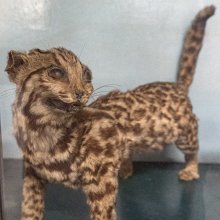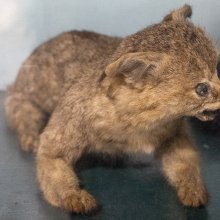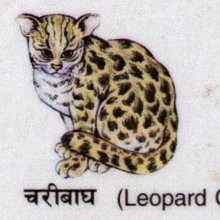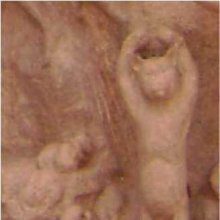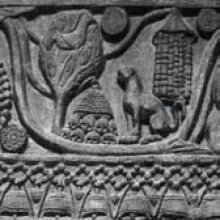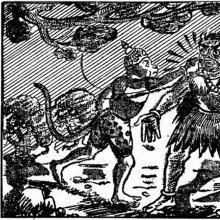Cat, Caṭ: 16 definitions
Introduction:
Cat means something in Buddhism, Pali, Hinduism, Sanskrit, the history of ancient India, Marathi, biology. If you want to know the exact meaning, history, etymology or English translation of this term then check out the descriptions on this page. Add your comment or reference to a book if you want to contribute to this summary article.
Alternative spellings of this word include Chat.
Images (photo gallery)
In Hinduism
Ayurveda (science of life)
Toxicology (Study and Treatment of poison)
Source: Shodhganga: Kasyapa Samhita—Text on Visha ChikitsaThe Cat is denoted by the Sanskrit term Biḍāla and is mentioned as one of the sworn enemies of Snakes (Sarpas), as taught in the Kāśyapa Saṃhitā: an ancient Sanskrit text from the Pāñcarātra tradition dealing with both Tantra and Viṣacikitsā (Toxicology).—The Kāśyapasaṃhitā (verse IV.33) talks about the sworn enemies of Sarpas (snakes): Boar, lightning, peacock, eagle, biḍāla (cat), mongoose and wolf are its sworn enemies.

Āyurveda (आयुर्वेद, ayurveda) is a branch of Indian science dealing with medicine, herbalism, taxology, anatomy, surgery, alchemy and related topics. Traditional practice of Āyurveda in ancient India dates back to at least the first millenium BC. Literature is commonly written in Sanskrit using various poetic metres.
In Buddhism
Tibetan Buddhism (Vajrayana or tantric Buddhism)
Source: academia.edu: The Structure and Meanings of the Heruka Maṇḍala1) The Cat is associated with the Yoginī (female deity) named Mārjārikī, being situated in the Medinīcakra, according to the 10th century Ḍākārṇava-tantra: one of the last Tibetan Tantric scriptures belonging to the Buddhist Saṃvara tradition consisting of 51 chapters.—Accordingly, the medinīcakra refers to one of the three divisions of the dharma-puṭa (‘dharma layer’), situated in the Herukamaṇḍala. The 36 pairs of Ḍākinīs [viz., Mārjārikī] and Vīras are yellow in color; the shapes of their faces are in accordance with their names [e.g., Cat]; they have four arms; they hold a skull bowl, a skull staff, a small drum, and a knife.
2) The Cat is also associated with the Yoginī named Bilāḍī or Biḍālī, being situated in the Vāyucakra.

Tibetan Buddhism includes schools such as Nyingma, Kadampa, Kagyu and Gelug. Their primary canon of literature is divided in two broad categories: The Kangyur, which consists of Buddha’s words, and the Tengyur, which includes commentaries from various sources. Esotericism and tantra techniques (vajrayāna) are collected indepently.
India history and geography
Source: Cologne Digital Sanskrit Dictionaries: Indian Epigraphical GlossaryCaṭ.—cf. alīkaṃ caṭāpitam (LP), ‘circulated a false rumour’. Cf. caṭanti (LP); ‘to accumulate’; also cf. Gujarātī cad8hśe. Note: caṭ is defined in the “Indian epigraphical glossary” as it can be found on ancient inscriptions commonly written in Sanskrit, Prakrit or Dravidian languages.
Source: Singhi Jain Series: Ratnaprabha-suri’s Kuvalayamala-katha (history)Cats were commonly depicted on the Saṃsāracakra paintings (representing scenes of animal life), in ancient India, as mentioned in the Kathās (narrative poems) such as Uddyotanasūri in his 8th-century Kuvalayamālā (a Prakrit Campū, similar to Kāvya poetry).—Page 185.21 f.: Here follows a description of a printed scroll illustrating the Jaina conception of saṃsāracakra. [...] The saṃsāra-cakra illustrated the three worlds of hell, human world and the world of gods. [For example:] A number of animals making a composite form, one upon another: spider caught in the web of another spider, the latter catching an insect pursued by a lizard and the latter caught by a black bird which flying in the sky with its feed was caught by a bird of prey, and the latter falling to the ground was caught by a wild cat which in turn was attacked by a wild boar, the latter was being attacked by leopard, and the leopard was attacked by a tiger, the latter instantaneously by a lion and the lion by a wild Śarabha (stronger than a lion and said to have eight feet).

The history of India traces the identification of countries, villages, towns and other regions of India, as well as mythology, zoology, royal dynasties, rulers, tribes, local festivities and traditions and regional languages. Ancient India enjoyed religious freedom and encourages the path of Dharma, a concept common to Buddhism, Hinduism, and Jainism.
Biology (plants and animals)
Source: Google Books: CRC World Dictionary (Regional names)Cat in Ethiopia is the name of a plant defined with Catha edulis in various botanical sources. This page contains potential references in Ayurveda, modern medicine, and other folk traditions or local practices It has the synonym Methyscophyllum glaucum Eckl. & Zeyh. (among others).
Example references for further research on medicinal uses or toxicity (see latin names for full list):
· Flora AegyptiacoArabica (1775)
· Enchiridion Botanicum (1841)
· A Voyage to Terra Australis (1814)
· Species Plantarum (1753)
· Fitoterapia (1991)
· Symbolae Botanicae (1790)
If you are looking for specific details regarding Cat, for example side effects, chemical composition, diet and recipes, pregnancy safety, extract dosage, health benefits, have a look at these references.

This sections includes definitions from the five kingdoms of living things: Animals, Plants, Fungi, Protists and Monera. It will include both the official binomial nomenclature (scientific names usually in Latin) as well as regional spellings and variants.
Languages of India and abroad
Marathi-English dictionary
Source: DDSA: The Aryabhusan school dictionary, Marathi-Englishcaṭ (चट्) [-kan-kara-dinī-diśī, -कन्-कर-दिनी-दिशी].—ad Imit. of the sound of a stroke with a whip or cane; smack!Whack!In a trice, jiffey,shake.
Marathi is an Indo-European language having over 70 million native speakers people in (predominantly) Maharashtra India. Marathi, like many other Indo-Aryan languages, evolved from early forms of Prakrit, which itself is a subset of Sanskrit, one of the most ancient languages of the world.
Sanskrit dictionary
Source: DDSA: The practical Sanskrit-English dictionaryCaṭ (चट्).—I. 1. P. (caṭati, caṭita)
1) To break, fall off, separate.
2) To rain.
3) To cover. -II 1 U. (cāṭayati -te)
1) To kill, injure.
2) To pierce, break.
--- OR ---
Cat (चत्).—1 U. (catati-te)
1) To ask, beg, request.
2) To go. -Caus. (cātayati-te)
1) To cause to hide.
2) To scare, terrify.
Source: Cologne Digital Sanskrit Dictionaries: Shabda-Sagara Sanskrit-English DictionaryCaṭ (चट्).—[caṭa] r. 1st. and 10th cls. (caṭati, cāṭayati-te) 1. To break, to pierce. 2. To kill, to injure. bhvādi-para-saka-seṭ . vadhe bhede ca curā-ubha-saka-seṭ .
--- OR ---
Cat (चत्).—[(e) cate] r. 1st cl. (catati-te) To ask, to beg, to solicit.
Source: Cologne Digital Sanskrit Dictionaries: Benfey Sanskrit-English DictionaryCaṭ (चट्).— (a dialectical form of cart. vb. cṛt), i. 1, [Parasmaipada.] 1. † To rain. 2. To cover. 3. To separate, [Pañcatantra] 121, 1. i. 10 (rather Causal), cāṭaya, 1. To separate. 2. † To kill.
— With the prep. ud ud, To disappear, [Bhāgavata-Purāṇa, (ed. Burnouf.)] 5, 9, 18. [Causal.] To drive out, [Bhāgavata-Purāṇa, (ed. Burnouf.)] 2, 7, 28.
--- OR ---
Cat (चत्).— i. 1, [Parasmaipada.], [Ātmanepada.] 1. To abscond (ved.). 2. † To ask.
Source: Cologne Digital Sanskrit Dictionaries: Cappeller Sanskrit-English DictionaryCaṭ (चट्).—caṭati [participle] caṭita happen, take place; arrive, get to or into ([locative]).
--- OR ---
Cat (चत्).—only catant & catta hide one’s self. [Causative] cātayati, only catant & catta hide one’s self. [Causative] cātayate scare, drive away. —nis, pra, & vi [Causative] [Middle] the same.
Source: Cologne Digital Sanskrit Dictionaries: Monier-Williams Sanskrit-English Dictionary1) Caṭ (चट्):—[class] 1. [Parasmaipada] ṭati, to fall in (as the flood), [Pañcatantra i, 12, 0/1];
—to reach (with [locative case]), fall to the share of or into, [Siṃhāsana-dvātriṃśikā or vikramāditya-caritra, jaina recension; Pañcadaṇḍacchattra-prabandha];
—to hang down from ([locative case]), [Subhāṣitāvali];
—to rain, [Dhātupāṭha ix, 6];
—to cover ([varia lectio] for √kaṭ), [ib.] :—[Causal] cāṭayati, to break, [xxx, 47];
—to kill, [ib.] (cf. uc-, vi-.)
2) Cat (चत्):—[class] 1. catati, ‘to hide one’s self.’ See catat and catta;
2) —to go, [Naighaṇṭuka, commented on by Yāska ii, 14];—[Parasmaipada] and [Ātmanepada] to ask, beg (= √cad), [Dhātupāṭha xxi, 5] :—[Causal] cātayati, te ([Aorist] acīcattam, acīcate, [Taittirīya-āraṇyaka ii, 4, 5 f.]), ‘to cause to hide’, scare, frighten away, [Ṛg-veda iv, 17, 9; x, 155, 1; Atharva-veda iv, xix] (cf. niś-, pra-, vi-; cf. also cātaka, cātana, cāttra.)
Source: Cologne Digital Sanskrit Dictionaries: Yates Sanskrit-English DictionaryCaṭ (चट्):—(ki) caṭati caṭayati 1. 10. a. To break, to pierce; to kill.
Source: DDSA: Paia-sadda-mahannavo; a comprehensive Prakrit Hindi dictionary (S)Caṭ (चट्) in the Sanskrit language is related to the Prakrit word: Uccuppa.
[Sanskrit to German]
Sanskrit, also spelled संस्कृतम् (saṃskṛtam), is an ancient language of India commonly seen as the grandmother of the Indo-European language family (even English!). Closely allied with Prakrit and Pali, Sanskrit is more exhaustive in both grammar and terms and has the most extensive collection of literature in the world, greatly surpassing its sister-languages Greek and Latin.
Kannada-English dictionary
Source: Alar: Kannada-English corpusCaṭ (ಚಟ್):—[noun] an onomatopoetic term used to express swiftness, quickness in action.
Kannada is a Dravidian language (as opposed to the Indo-European language family) mainly spoken in the southwestern region of India.
See also (Relevant definitions)
Starts with (+2031): Cat berry, Cat can, Cat herb, Cat island bush, Cat korundoo unnay, Cat loi, Cat tail millet, Cat whiskers, Cat-aralie, Cat-catenal, Cat-claw mimosa, Cat-curutirishapam, Cat-head, Cat-iracavarkkam, Cat-thorn, Cata, Cata-carvakalam, Cata-cataenal, Cata-civatattuvam, Cata-civatevar.
Ends with (+20): Abhipashcat, Abhyarcat, Adipashrcat, Ahuacat, Aprayuccat, Arcat, Asashcat, Atipashcat, Avocat, Ayacat, Cancat, Che cat, Dakshinapashcat, Dvicat, Kayu pacat, Muncat, Nicat, Nikcat, Nocat, Pacat.
Full-text (+1045): Marjara, Baidala, Bidala, Vidala, Menada, Vrishadamsha, Otu, Vaidalavratika, Gandhamarjara, Mandalin, Mrigacaitaka, Jihvapa, Vrishahara, Salavrika, Naktacarin, Vilala, Marjariya, Myaum, Manjari, Ghariya.
Relevant text
Search found 163 books and stories containing Cat, Caṭ; (plurals include: Cats, Caṭs). You can also click to the full overview containing English textual excerpts. Below are direct links for the most relevant articles:
Folklore of the Santal Parganas
Chapter CXIV - The Tigers and the Cat < [Part II]
Chapter CLXIV - The Transmigration of Souls < [Part V]
Chapter XXII - Lita and His Animals < [Part I]
Philosophy of language in the Five Nikayas (by K.T.S. Sarao)
2. Theories of Meaning < [Chapter 3 - Language and Meaning as Reflected in the Five Nikāyas]
3. Semantics (study of formal theories of meaning) < [Chapter 3 - Language and Meaning as Reflected in the Five Nikāyas]
5. Language Comprehension < [Chapter 2 - Concept of Philosophy of Language]
The Jataka tales [English], Volume 1-6 (by Robert Chalmers)
Jataka 137: Babbu-jātaka < [Book I - Ekanipāta]
Jataka 383: Kukkuṭa-jātaka < [Volume 3]
Jataka 512: Kumbha-jātaka < [Volume 5]
Different Aspects of Mindfulness (by Dhammasami)
Chaitanya Bhagavata (by Bhumipati Dāsa)
Verse 2.8.19-021 < [Chapter 8 - The Manifestation of Opulences]
Verse 1.2.65 < [Chapter 2 - The Lord’s Appearance]
Verse 3.5.341 < [Chapter 5 - The Pastimes of Nityānanda]
Related products
